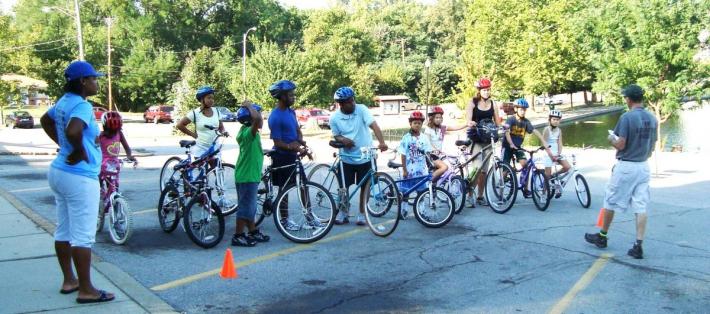
Where are the newest Bicycle Friendly Communities? Many of them are in the 'burbs.
As we mentioned a few days ago, more suburban-style communities received the League of American Bicyclists’ BFC honor this week. That's a shift from previous years. “The national boom in biking has officially found a pedal-hold in a previously unlikely place: the suburbs,” writes the League’s Liz Murphy. “Urban centers aren't the only areas making biking better for millions of Americans.”
Facebook’s corporate home of Menlo Park, California, which neighbors Palo Alto, moved up to Silver status in this round. (Facebook itself is Gold-level Bicycle Friendly Business.) Ferguson, Missouri, on the outskirts of St. Louis, gives free bikes to local youth with its Earn-a-Bike program, and is making other bike- and pedestrian-friendly improvements. And Murphy reports that in the Chicago ‘burbs, Elmhurst, Illinois, “has so many children who bike to school -- between 10 and 20 percent -- that they recently had to install hundreds of additional bike racks [at] local schools." The town has been going after BFC designation for four years.
Maybe it shows the mainstreaming of bicycling across the country. Or maybe it’s just that all the usual suspects have been on the League’s list for years already and now the org is looking to the second tier.
We wanted to hear more about this suburban bicycling renaissance, so we checked in with the League's Bill Nesper, director of the Bicycle Friendly America program. He said suburbs often have more work to do than bigger cities to become bike-friendly because of the challenges implicit in their land use. “Places that don’t really have the density, the average trip distance might not be as short as in a place like New York or Chicago,” said Nesper, “but that isn’t stopping them from making improvements to make bicycling easier for everybody.”
In many places where the car is king, you often hear people saying, “My child’s school is so close we can see it from our house, but the streets don’t connect,” or “you have to cross a six-lane highway,” or “there’s no sidewalk.” So it’s not all about distance. Sometimes all that’s needed is a retrofit. Nesper said when these communities create pedestrian cut-throughs in cul-de-sacs or calm traffic to make busy streets friendlier for people walking and biking, that can go a long way. Some also draw attention to quiet, bikeable streets with signage and “bike boulevard” designation.
A simple striped bike lane that might be sufficient on a narrow city street with slow-moving traffic might be inadequate on a suburban arterial, and the League takes those differences into account. Nesper notes that their evaluations of BFC applications aren’t just by the numbers. “We rely on local reviewers who are in the field to say, ‘This bike lane is substandard,’ or ‘This road is not a low speed street,’” he said. In those places, a buffered bike lane might be called for.
“We also look at the percentage of streets with posted speeds of 25 miles per hour or lower,” he added. “And we’re also interested in network density and connectivity.”
And it’s not just infrastructure. Communities also get points for gathering residents together for group rides, training law enforcement, or teaching safe riding skills.
As more small towns and suburban communities join the Bicycle Friendly Community roster, it becomes easier for others like them to start thinking about what they can do to improve their own cycling, and perhaps one day get their own aluminum BFC sign. They call Nesper up asking for an apples-to-apples model of small or suburban towns aiming high on bike improvements -- and more and more, he has something to tell them.
Some towns that look small by population are tourist towns, like Crested Butte, Colorado: population 1,497; or Sisters, Oregon: population 1,925. So their small residential populations belie a much larger potential audience for biking and walking, and they often have more compact development. After all, attractive places to walk and bike become tourist magnets for a reason.
There are now 291 Bicycle Friendly Communities [PDF] in 48 states.





